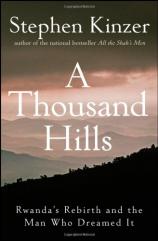A Thousand Hills: Rwanda's Rebirth and the Man Who Dreamed It
Review
A Thousand Hills: Rwanda's Rebirth and the Man Who Dreamed It
Those of us who are of a "certain age," as well as pop music aficionados of any age, are well acquainted with a hit by The Orlons back in the early 1960s --- a ditty titled "The Wah-Watusi" that prompted a dance move better left forgotten. The word Watusi referred to an African people who were actually known as Batutsi, and later, simply Tutsi.
In 1994, nearly a million Tutsi were slaughtered by their Rwandan friends, neighbors and, in some cases, relatives who were members of the Hutu tribe. As European leaders quietly fomented the slaughter and the U.N. failed to intervene on any meaningful level, the U.S. simply looked away. Since 1995, when I wrote my first article on the Rwanda genocide, I've wondered if ordinary Americans would have paid greater attention to the horror had they known that their beloved, pop-cultured Watusi were the victims.
Even today, many Americans have little understanding of the magnitude of the mass murders that took place over several months in 1994. Don Cheadle's 2004 movie, Hotel Rwanda, helped, but it couldn't tell the whole story.
Stephen Kinzer, however, seems to have done just that. He tells the whole story, or at least as much as would fit in 350-plus pages, in A THOUSAND HILLS. It's a monumental effort and one that deserves the attention of a world that looked the other way as its leaders pondered the meaning of the word "genocide" and whether it actually applied to what they maintained was a civil war and thus an internal matter for Rwandans.
Kinzer effectively uses the words of Rwandan President Paul Kagame to tie together this half-century history of the nation. With more than 30 hours of taped interviews at his disposal, Kinzer lets Kagame --- alternately praised as a savior and denounced as a despot by various observers --- tell that history from his perspective and provide analysis of all that went wrong then and all that's going right now. Kagame's comments offer priceless insights into Rwandans and the international community.
Kinzer opens the story with this gripping sentence: "Everything important in Rwanda happens on a hill, so it was logical for Paul Kagame's mother to take him out onto a hillside to be murdered." Few, if any, readers would be able to stop at that, and so they would be hooked --- for a while. But this is not a book for the casual reader; rather, it is one for full-throated followers of African history, international relations, human rights abuses and the failure of political leaders.
The subtitle refers to Rwanda's "rebirth," which is taking place today because of Kagame's insistence that reconciliation between the Hutu and the Tutsi is the only path to recovery and restoration. Defying conventional wisdom and the heavy-handed, militaristic pattern set by neighboring countries emerging from strife, Kagame opened the country to returning refugees and survivors who would resettle among the very people who terrorized them and slaughtered their families. With the help of religious leaders such as Anglican Bishop John Rucyahana, Rwandans began the slow and painful process of learning to live together again, and in some cases, learning to forgive their enemies.
It's in this latter area that the book falters. Few stories of forgiveness and reconciliation are included, and yet there are hundreds to be told. For those who are finally paying attention, Rwanda has become a beacon of hope by shining a stunning light on the possibility that genuine forgiveness can exist in the aftermath of inhuman brutality. Without concrete stories of people who have achieved this possibility, reconciliation and forgiveness remain abstract ideals. But many of those stories are there for the taking, and their inclusion would have breathed life into this story of Rwanda's rebirth.
Reviewed by Marcia Ford on June 3, 2008
A Thousand Hills: Rwanda's Rebirth and the Man Who Dreamed It
- Publication Date: June 3, 2008
- Genres: Christian
- Hardcover: 400 pages
- Publisher: Wiley
- ISBN-10: 0470120150
- ISBN-13: 9780470120156




